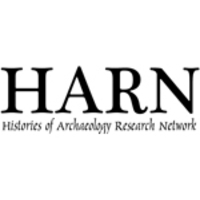- Archaeology, History of Archaeology, History of Classical Archaeology, History of Scholarship, History of Science, History of Egyptology, and 19 moreHistory of Anthropology, Prehistoric Archaeology, Classical Archaeology, Egyptology, Medieval Archaeology, Historical Archaeology, Experimental Archaeology, Greek Archaeology, Public Archaeology, Byzantine Archaeology, Digital Archaeology, Underwater Archaeology, Mediterranean archaeology, Industrial Archaeology, Biography, The history of archaeology, History, Anthropology, and Roman Archaeologyedit
- HARN OFFICIAL WEBPAGE: http://harngroup.wordpress.com HARN WELCOMES NEW MEMBERS. If you would like to If you wou... moreHARN OFFICIAL WEBPAGE: http://harngroup.wordpress.com
HARN WELCOMES NEW MEMBERS. If you would like to
If you would like to join our research network, please contact Ulf R. Hansson at HARNgroup@googlemail.com with contact information, academic affiliation and a synopsis of your research interests
The Histories of Archaeology Research Network, HARN, was founded in 2008 by Pamela Jane Smith and is now run by Pamela Jane Smith, Ulf R. Hansson, Julia Roberts, Kathleen Sheppard MacDonald, and Olga Sveshnikova. HARN is an inter-university and interdisciplinary e-mail network which provides an overarching, cross-institutional structure to promote communication and to support shared ideas and innovative new work.
Members attempt to untangle the histories and philosophies of archaeology and reconstruct the lesser-known social, political and intellectual aspects of archaeology's history. HARN participants are investigating previously unexamined archival and primary sources and gathering original oral-historical evidence. They produce innovative, fine-grained descriptions and in-depth historical analyses based on entirely fresh material. The resulting new research is regularly submitted to Antiquity's Project Gallery. An example is Kathleen Sheppard's examination of Flinders Petrie's promotion of 'the solutions eugenics offered to the ills of society' <http://antiquity.ac.uk/projgall/sheppard/>.
HARN now consists of about 130 participants from across the world. New members and all queries are welcomed. For more information please contact HARN at HARNgroup@googlemail.com
Please also visit HARN's blog at http://harngroup.wordpress.com where anyone interested in the history of archaeology can post announcements or comments or initiate discussion.edit
Research Interests:
Research Interests:
Research Interests:
Research Interests:
Research Interests:
Research Interests:
Research Interests:
Research Interests:
Research Interests:
Research Interests:
Research Interests:
Research Interests:
Research Interests:
Research Interests:
Research Interests:
Research Interests:
Research Interests:
Research Interests:
Research Interests:
Research Interests:
Research Interests:
Research Interests:
Research Interests:
Research Interests:
Research Interests:
Research Interests:
Research Interests:
Research Interests:
Research Interests:
Research Interests: Archaeology of pre-Roman Italy, Greek Archaeology, History of Archaeology, Archaeology, Classical archaeology, Greek and Roman history, Greek Colonization (Magna Graecia and Sicily), Material Culture Studies, Funerary Archaeology, History of Greek Archaeology, and 3 moreRoman Archaeology, History of Classical Archaeology, and History of Roman Archaeology
Research Interests:
Research Interests:
Research Interests:
Research Interests: History of Science, History of Social Sciences, History of Anthropology, History of Scholarship, History of Egyptology, and 7 moreHistory of Archaeology, History of Antiquarianism, History of Art and archaeology, History of Archaeology - Antiquarianism - Classical Tradition, History of Collecting and Antiquarianism, History of Classical Archaeology, and History of Archaeology and Anthropology
Research Interests:
Research Interests:
Research Interests:
Research Interests:
Research Interests:
Research Interests:
Research Interests:
Research Interests:
HARN would like to know about the activities of our members (conferences, workshops, talks, exhibitions, publications and other news) that might be of interest to all or some of us. Please send any such information to Ulf... more
HARN would like to know about the activities of our members (conferences, workshops, talks, exhibitions, publications and other news) that might be of interest to all or some of us. Please send any such information to Ulf (ulf.hansson@austin.utexas.edu) for posting here or on HARN's other pages on the web (weblog, facebook). Thanks!
Research Interests:
Research Interests:
Research Interests:
Conference Report by Csaba Szabo
Research Interests:
Conference Report
